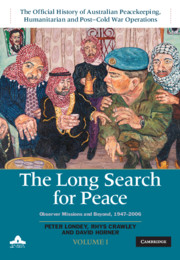Book contents
- The Long Search for Peace
- The Official History of Australian Peacekeeping, Humanitarian and Post–Cold War Operations
- The Long Search for Peace
- Copyright page
- Contents
- Maps
- Preface
- Glossary
- Part 1 Actor and observer
- Part 2 New ambitions
- 16 The new internationalists
- 17 A ‘lop-sided’ umpire
- 18 Snow Goose and the Milk Run
- 19 An island divided
- 20 Desert sortie
- 21 On the Golan
- 22 Witnesses to civil war
- 23 Fumbling the political football
- 24 The tribe that lost its head
- 25 Into Africa
- 26 A dangerous but crucial mission
- 27 The healing touch
- 28 ‘The only show in town’
- Part 3 Carrying on
- Conclusion
- Book part
- Bibliography
- Index
- Plate Section (PDF Only)
28 - ‘The only show in town’
Commonwealth Military Training Team – Uganda, 1982–84
from Part 2 - New ambitions
Published online by Cambridge University Press: 27 September 2019
- The Long Search for Peace
- The Official History of Australian Peacekeeping, Humanitarian and Post–Cold War Operations
- The Long Search for Peace
- Copyright page
- Contents
- Maps
- Preface
- Glossary
- Part 1 Actor and observer
- Part 2 New ambitions
- 16 The new internationalists
- 17 A ‘lop-sided’ umpire
- 18 Snow Goose and the Milk Run
- 19 An island divided
- 20 Desert sortie
- 21 On the Golan
- 22 Witnesses to civil war
- 23 Fumbling the political football
- 24 The tribe that lost its head
- 25 Into Africa
- 26 A dangerous but crucial mission
- 27 The healing touch
- 28 ‘The only show in town’
- Part 3 Carrying on
- Conclusion
- Book part
- Bibliography
- Index
- Plate Section (PDF Only)
Summary
In early 1982, the Australian Government agreed to provide a five-man contingent as part of a 36-strong, seven-country Commonwealth operation: the Commonwealth Military Training Team – Uganda (CMTTU). The CMTTU arose from the 1981 Melbourne Commonwealth Heads of Government Meeting and was tasked by the Commonwealth with training officers and non-commissioned officers (NCOs) in the Uganda National Liberation Army (UNLA), formed after the overthrow of the dictator Idi Amin. The other countries taking part were Great Britain, Guyana, Jamaica, Sierra Leone and Tanzania; Canada provided a medical team. From March 1982 to March 1984, Australia provided four teams, each of five men (a major, a captain, a warrant officer class 2 and two sergeants). Each team served for six months, and in all 20 Australian soldiers served in Uganda during this time. The Australians helped train more than 3500 Ugandan soldiers in minor tactics, field craft and weapon handling. Twenty years after the Vietnam War and almost a decade before the 1990s expansion in Australian peacekeeping, Uganda was truly the ‘only show in town’ for soldiers desiring deployment abroad.
- Type
- Chapter
- Information
- The Long Search for PeaceObserver Missions and Beyond, 1947–2006, pp. 690 - 714Publisher: Cambridge University PressPrint publication year: 2019



